Upgrading our house battery system, part 2; life is better with lithium
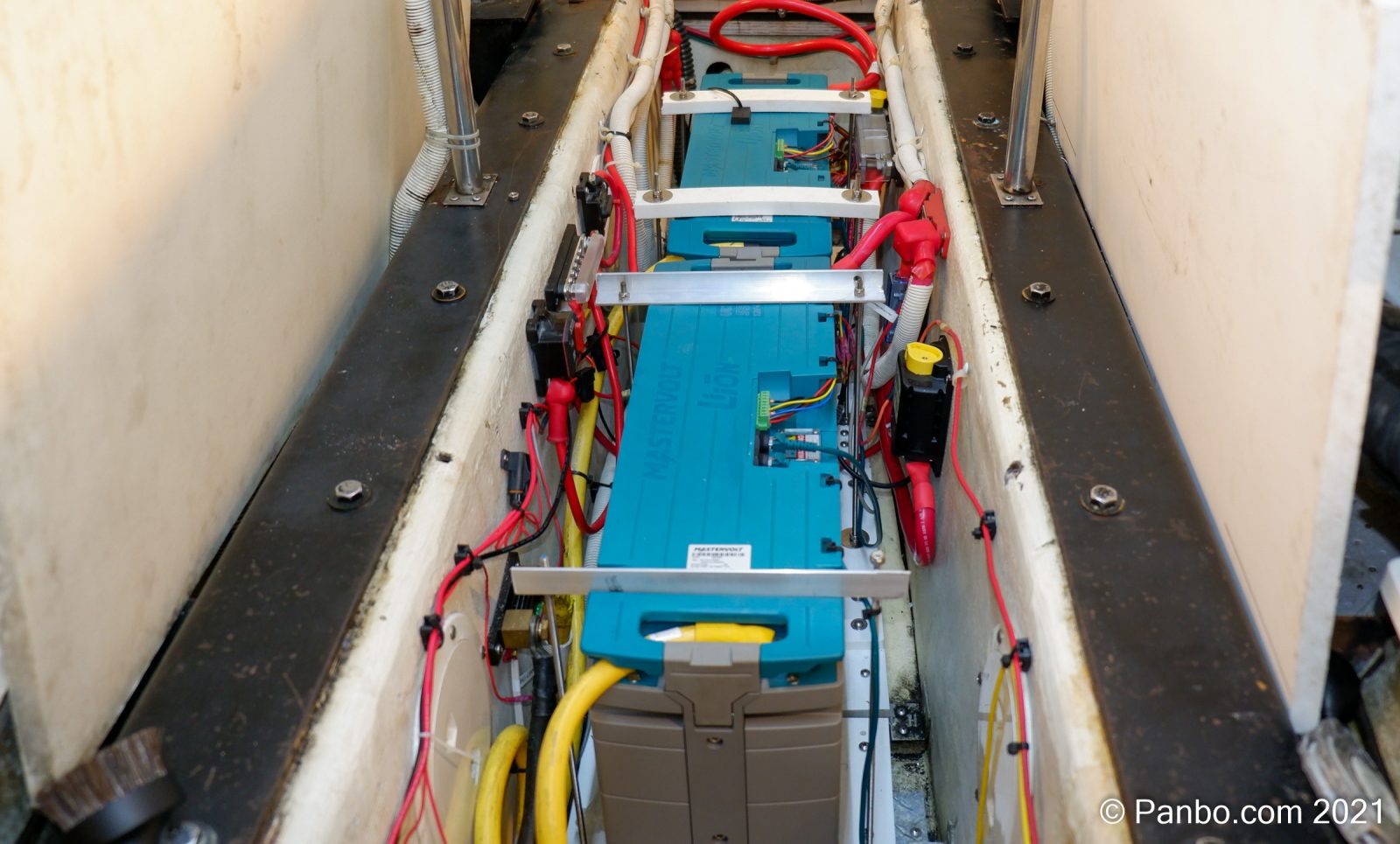
In part one of this series, I explained our motivations for upgrading to a lithium house battery bank, my choice of all Mastervolt components, and the pleasing results of early testing. Now let’s talk about what makes lithium different and what you need to consider if you too plan an upgrade. Active battery monitoring and control are critical to protecting other power components, for instance, and there are other important install details. Plus, I’ve got more real-world testing results to share.
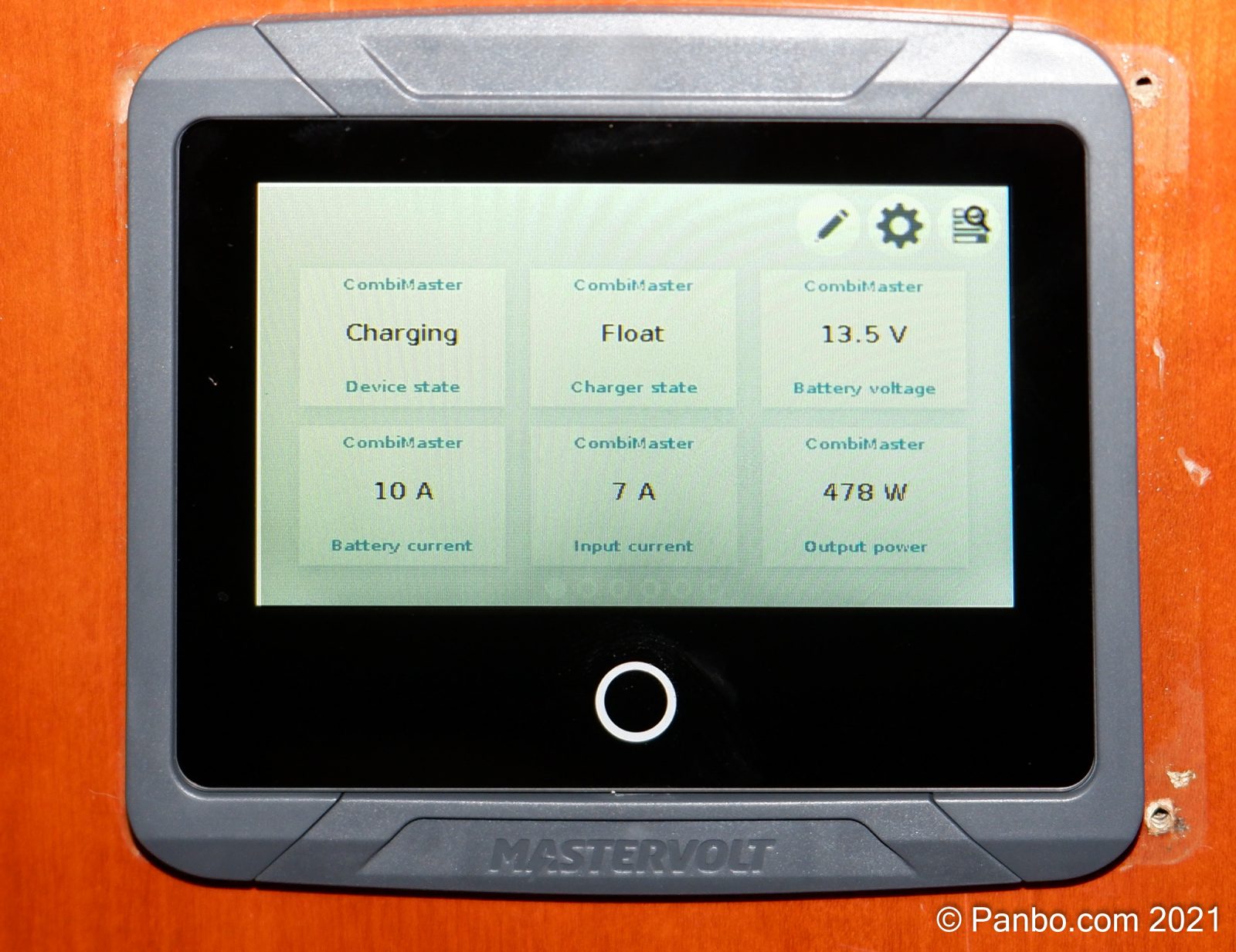
It’s said that a lithium battery bank should be thought of as a whole system, like an engine, with several important accessory components. So switching to lithium power storage is not simply a matter of swapping batteries. Every boat built in the last 50 years, for instance, has chargers, alternators, and distribution components meant to support the various lead-acid battery types, not the decidedly different lithium iron phosphate (LiFePo4) charge and discharge characteristics discussed in part one.
Moreover, a LiFePO4 battery install should also include a battery management system (BMS) and safety relays to ensure normal and safe operations. If the individual battery cells are out of balance, for instance, the BMS can balance them. If the battery gets too cold or hot, or it’s hit with too large a load, the BMS can trigger the safety relays to shut it down until safe parameters are restored. Relion Energy has an easy-to-understand blog post about the whys and hows of lithium battery management systems.
But the differences in discharge and charge behavior also make lithium batteries more efficient and in many ways friendlier to the equipment on board, which also impacts the economics of a lithium conversion. My recent Lithium Math discussion dove deep into this subject and I hope you’ll take a few minutes to understand how the tech differences affect the overall cost. But the most important points to understand are that lithium batteries deliver more usable power from similar specs and do so with more consistent voltage.
Types of LiFePO4 batteries
For our discussion, I’m going to break down the various LiFePO4 battery options into three basic categories:
- System-integrated batteries — These are purpose built batteries designed to work as part of an integrated system with charge sources, monitoring, and status displays included. Victron and Mastervolt are the two major manufacturers making products in this category.
- Drop-in batteries — Drop-in batteries are designed to replace existing 12v batteries with minimal changes. All of the reputable drop-in batteries will have a BMS built in, but it’s very unlikely that BMS will communicate externally with charge, safety, or display systems.
- DIY batteries — There are many sources of individual LiFePO4 cells, BMS modules, and other components to make your own 12v battery. The configuration of these can vary widely depending on what you select, as can their ability to communicate with other on-board systems.
Each of these three options comes with plusses and minuses. As you might imagine, one of the biggest variables is the cost per watt hour. DIY batteries are typically the least expensive, but come with a need for more knowledge, skill, and work from the boater. Additionally, building a DIY battery properly can require some tools like bench power supplies, quality electrical meters, and more. Plus, if not well built and installed, DIY batteries can be dangerous.
Drop-in batteries are a good compromise on cost per watt hour and total install cost. As the name implies, they are intended to drop into the place of another 12-volt chemistry and work without major modifications, though upgraded charge sources my be needed to get the most benefit from the new bank.
Drop-in lithium batteries also don’t usually communicate with other components in the DC system. Their built-in management systems are designed to protect them from out-of-range ambient temperatures, over-charging, or overloading by disconnecting them, but some components, especially alternators, can be damaged by a sudden battery disconnect.
Second battery installed
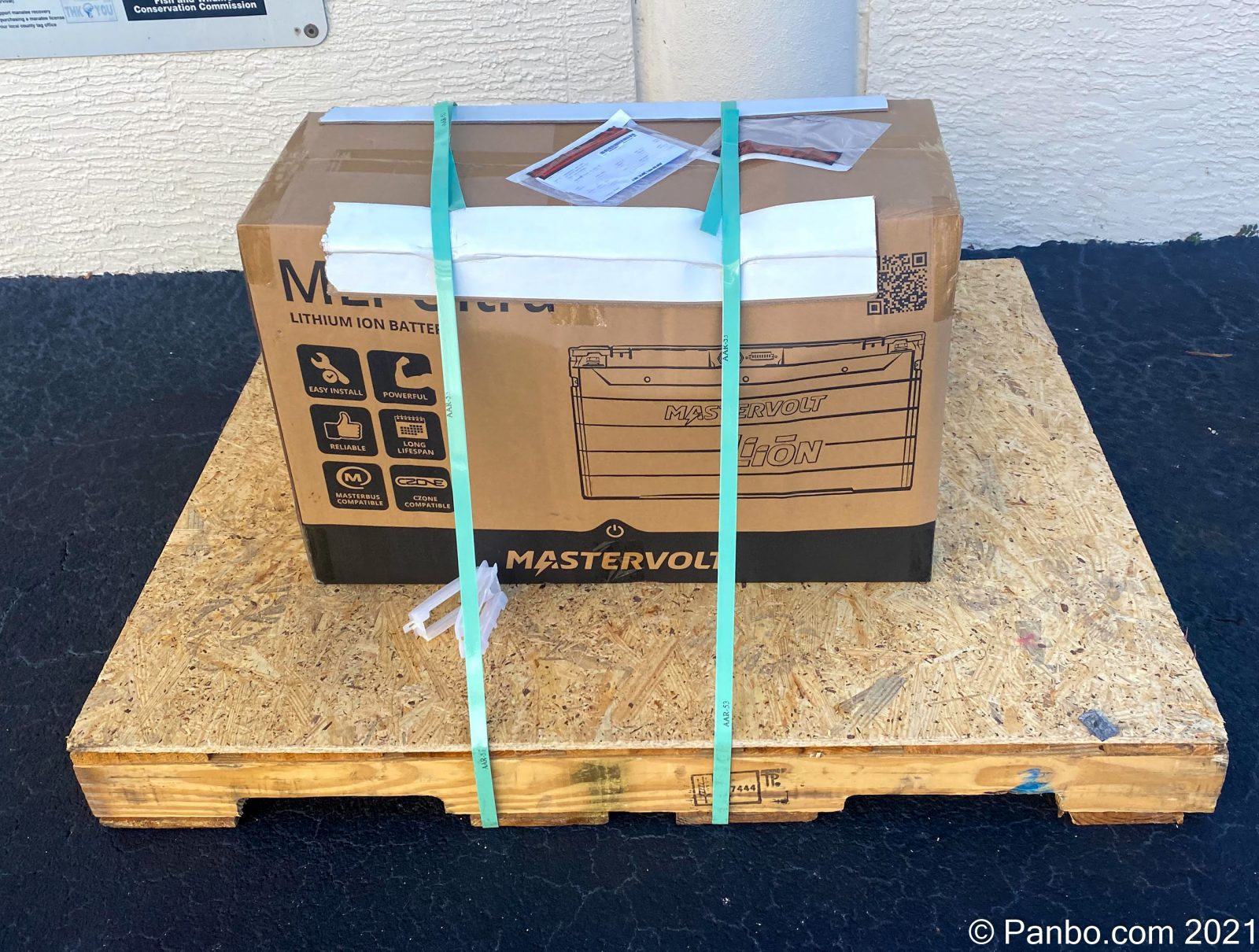
When I installed the first Mastervolt MLi Ultra 12/5500 battery, I also prepared for the second battery when I installed the first, so finishing the whole 11,000 watt hour bank was a pretty quick affair.

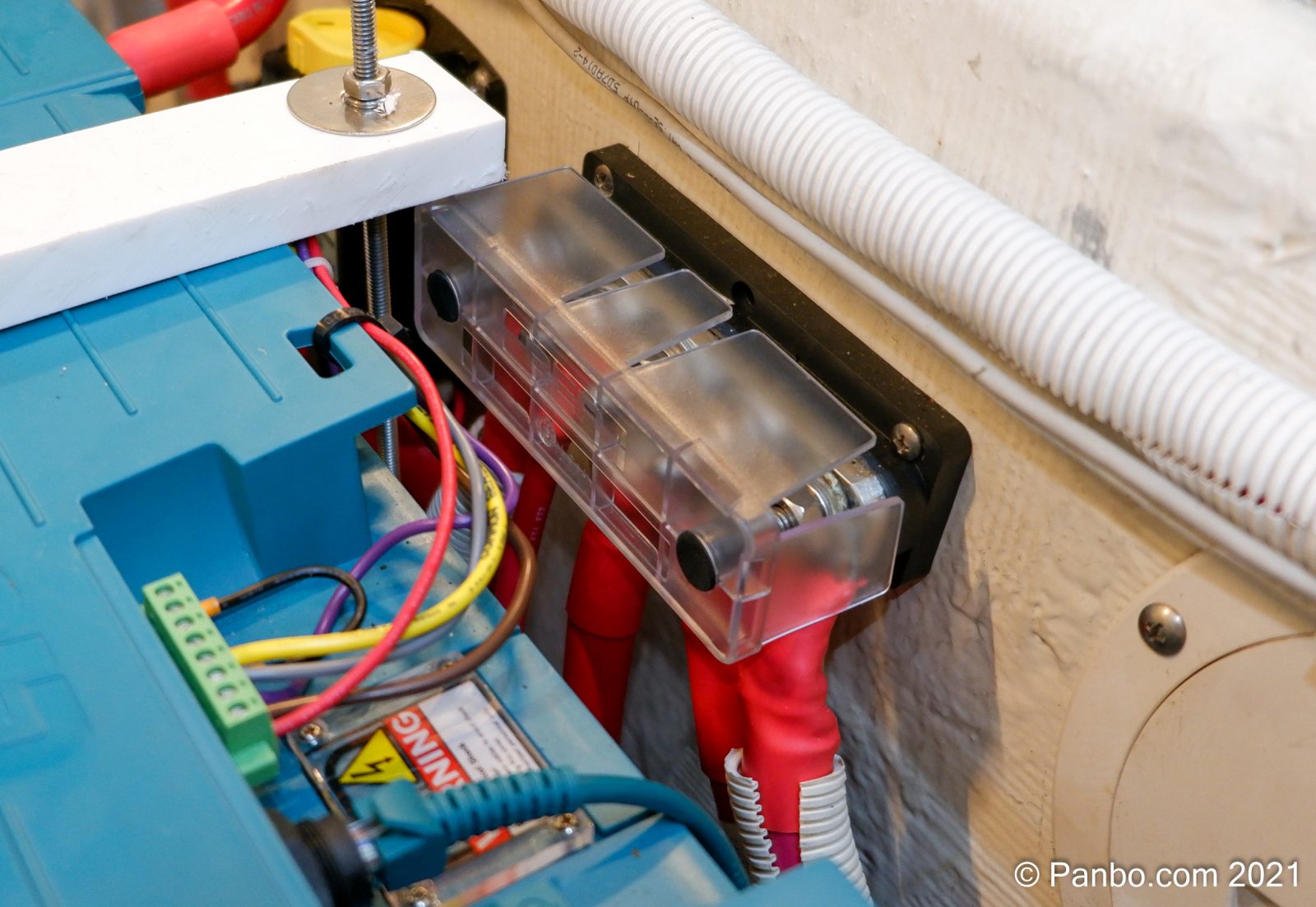
My previous lead-acid bank consisted of eight 6v batteries in parallel and serial. I paid a great deal of attention to that bank’s cables and eventually selected method 2 from SmartGauge’s excellent tutorial on how to wire up various battery combinations. While that strategy pulled positive from one end of the bank and negative from the opposite end, method 3 — using positive and negative cable runs that are each exactly equal length from each battery to a single bus bar or terminal post — was said to be preferred, though possibly not worth the hassle. I agreed given eight batteries, but with only two to deal with this time, the optimal method 3 was easily achieved. In theory, this should ensure that each new lithium battery charges and discharges at the same rate.
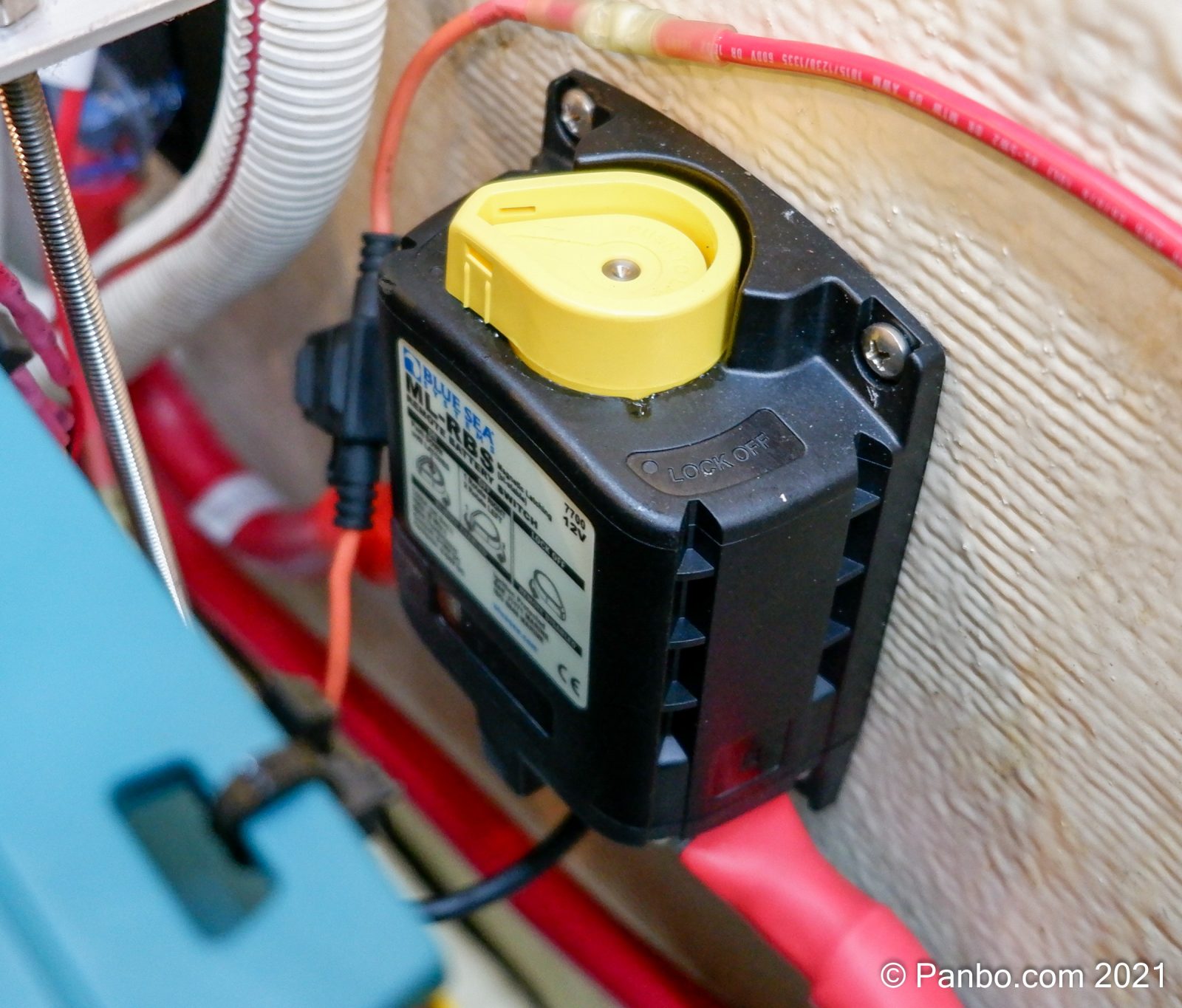
Mastervolt uses a 500-amp Blue Sea Systems ML-RBS remote battery switch connected to and controlled by each MLi battery. The remote battery switch acts as a safety relay that the MLi’s BMS can use to disconnect the battery if anything goes wrong.
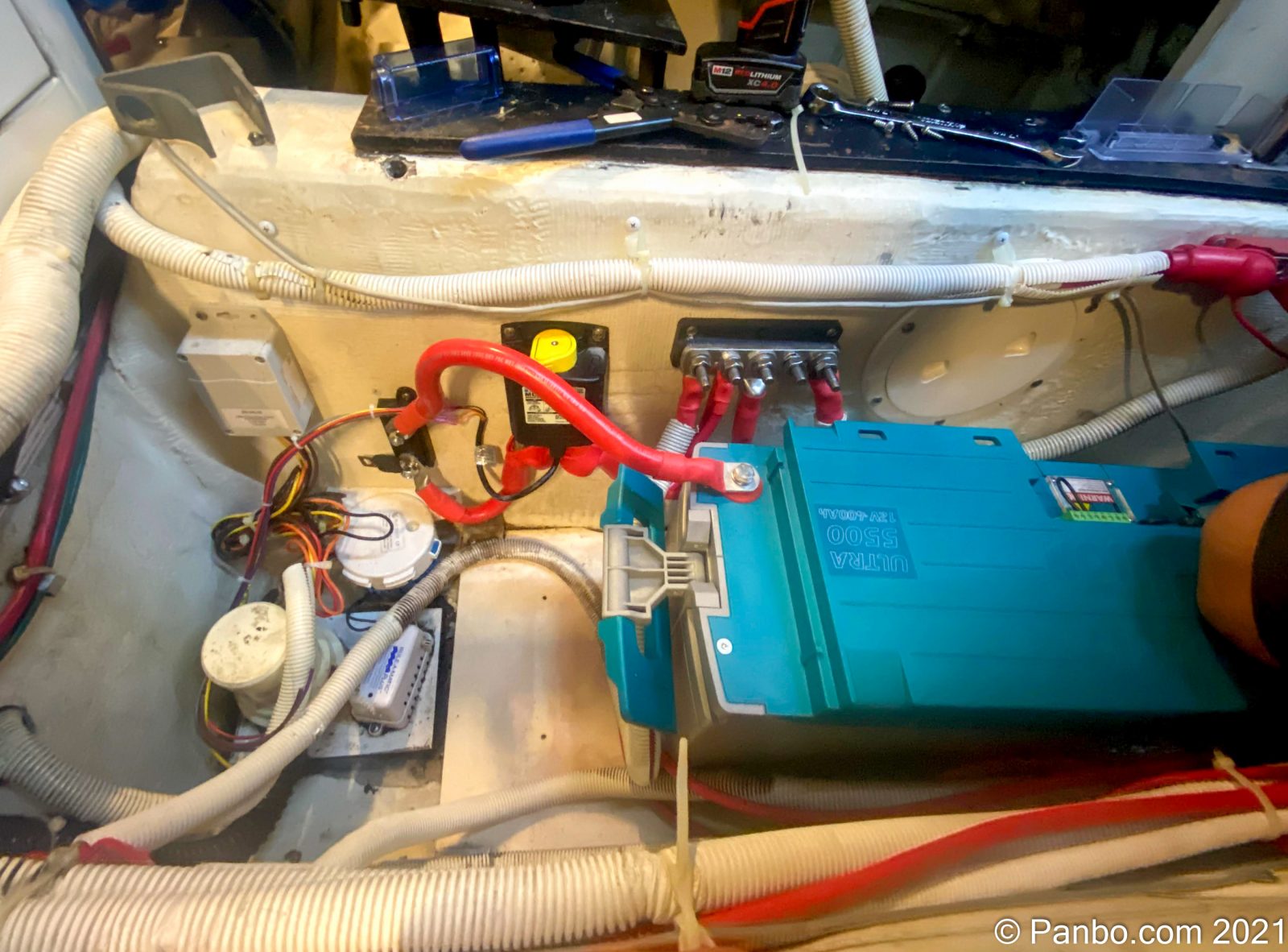
To complete the connections I connected the battery negative by 4/0 battery cable to the pre-battery monitor shunt bus-bar and the positive from the battery to a T-class fuse, the T-class fuse to the safety relay, and the safety relay to the positive bus-bar. The control systems also need to be connected for each MLi battery. These consist of five control wires for the safety relay and a Cat5 cable for MasterBus. There’s more to come on MasterBus in my next installment.
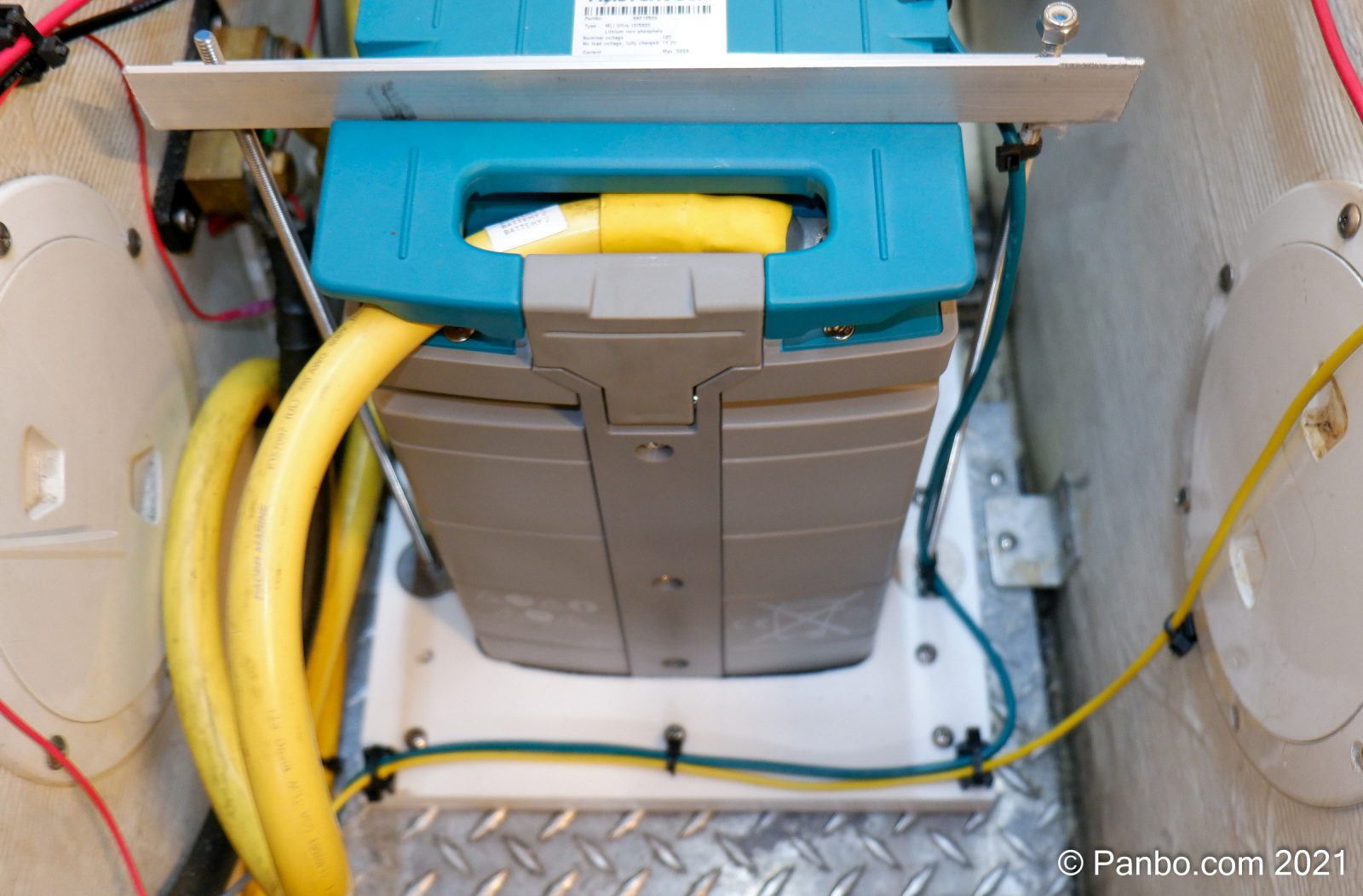
Notice how I made Starboard bases to secure each battery along with aluminum bars across the top to hold them down. Mastervolt does include two nylon tie-down straps for each battery, but I found them inadequate for the task, especially given the 125-pound battery weight.
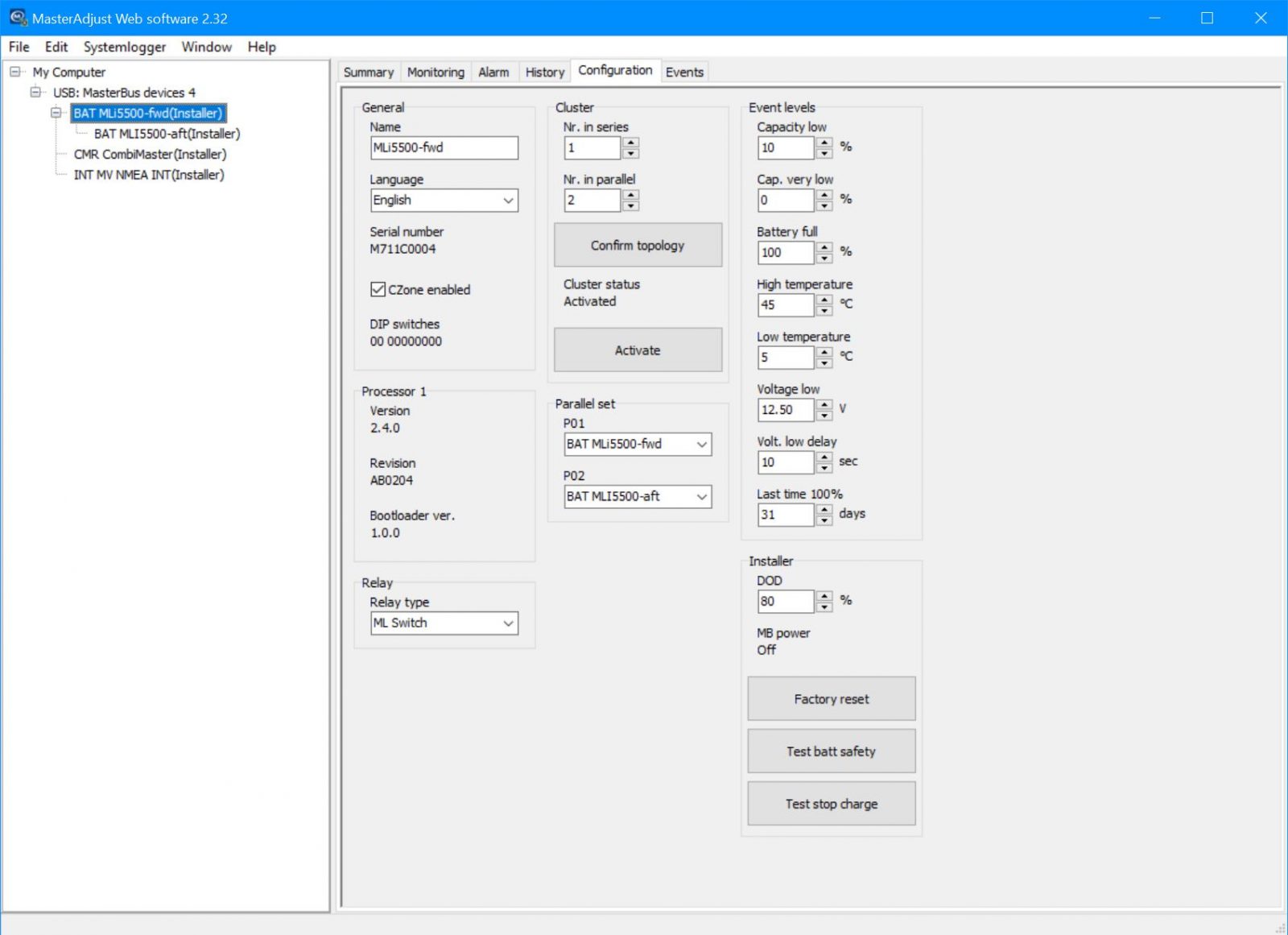
Now that both batteries are installed, it’s time to tell MasterBus that the two batteries will be used together to form a single battery bank. This is done in Mastervolt’s MasterAdust software with a computer connected to the MasterBus network via a MasterBus to USB interface. Now that the batteries have been combined into a cluster, MasterBus can report on the two batteries as a single bank. This means that capacity, runtime estimates, energy consumption, and voltage measurements are all reported at the cluster level instead of on a per battery basis.
Monitoring the batteries

I’m a long-time user and fan of Victron’s BMV battery monitors and the closely related SmartShunt but, good as they are, those monitors are external to the battery and can only report what they’ve measured at the battery bank level. With MasterBus connected batteries I not only get the battery bank level information I discussed above but also detailed information on each battery like cell temperature and voltage, plus cell balancing activity. I also like the peace of mind knowing that any anomaly detected by the BMS will be reported via the MasterBus network and displayed on the EasyView 5.
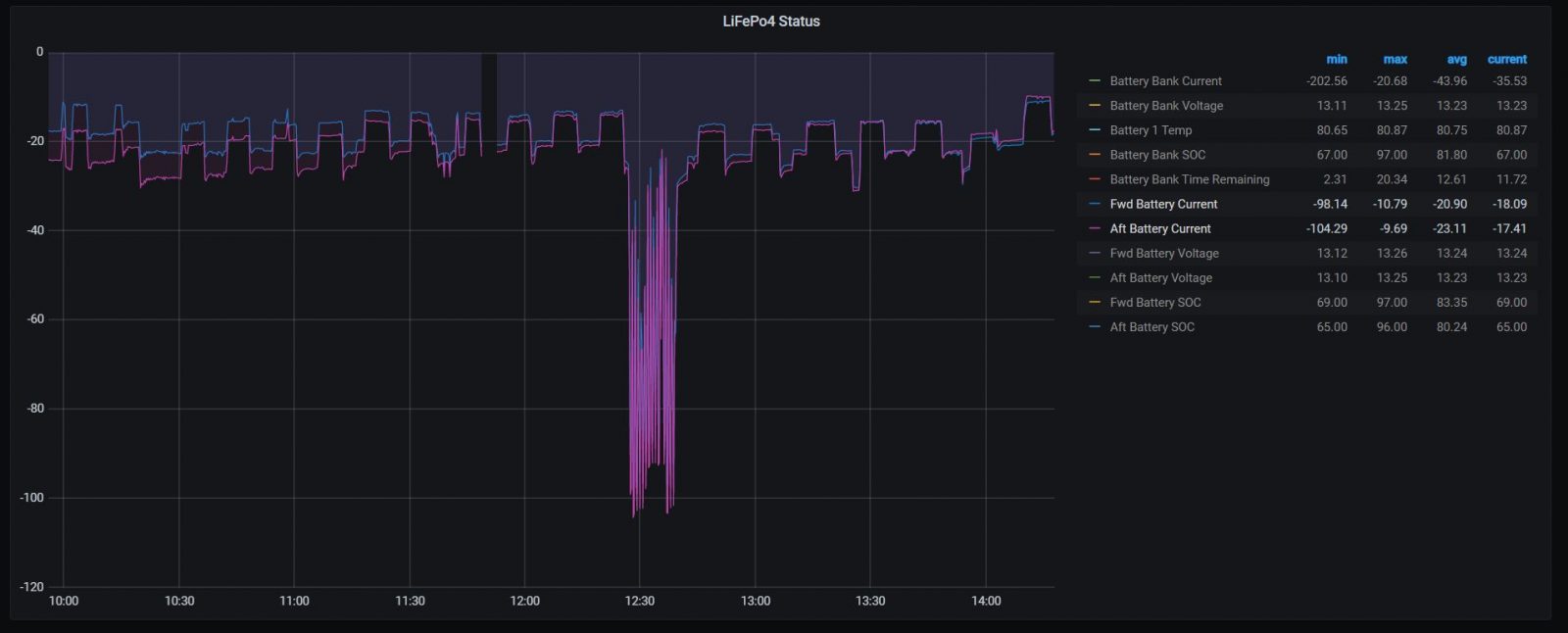
Individual battery monitoring has allowed me to see interesting — though harmless, I think — differences between the batteries. As you can see in the graph above, for instance, at first the aft battery provides a little more of the energy needed, but after several hours and as the state of charge declines, the forward battery takes the lead. I’ve never seen the two batteries more than two-percent apart in total state of charge, so I have just chalked it up to slight variations in the batteries. And I’ll add that in most battery installs you’d have no idea what’s happening on a per battery basis.
During my early testing, I had myself convinced there was something wrong somewhere in the system. I was comparing the state of charge as reported to MasterBus to the SOC reported by the Victron BMV, and the former was consistently lower than the latter. But Mastervolt quickly set me straight; they calculate SOC based on usable energy, not total bank capacity. So, if you set the battery for a maximum 80% depth of discharge, it will report it is 0% state of charge when it reaches what I used to think of as 20% SOC.
This makes sense, but it’s also quite different from how many of us are accustomed to understanding state of charge. With my BMV-monitored FLA bank, I never wanted to go below 50% SOC because deeper lead-acid discharges caused greater wear. Mastervolt’s approach is more like what electric car and cell phone manufacturers do, telling you how much of the usable energy remains in your batteries, not what’s left on the way to flat dead.
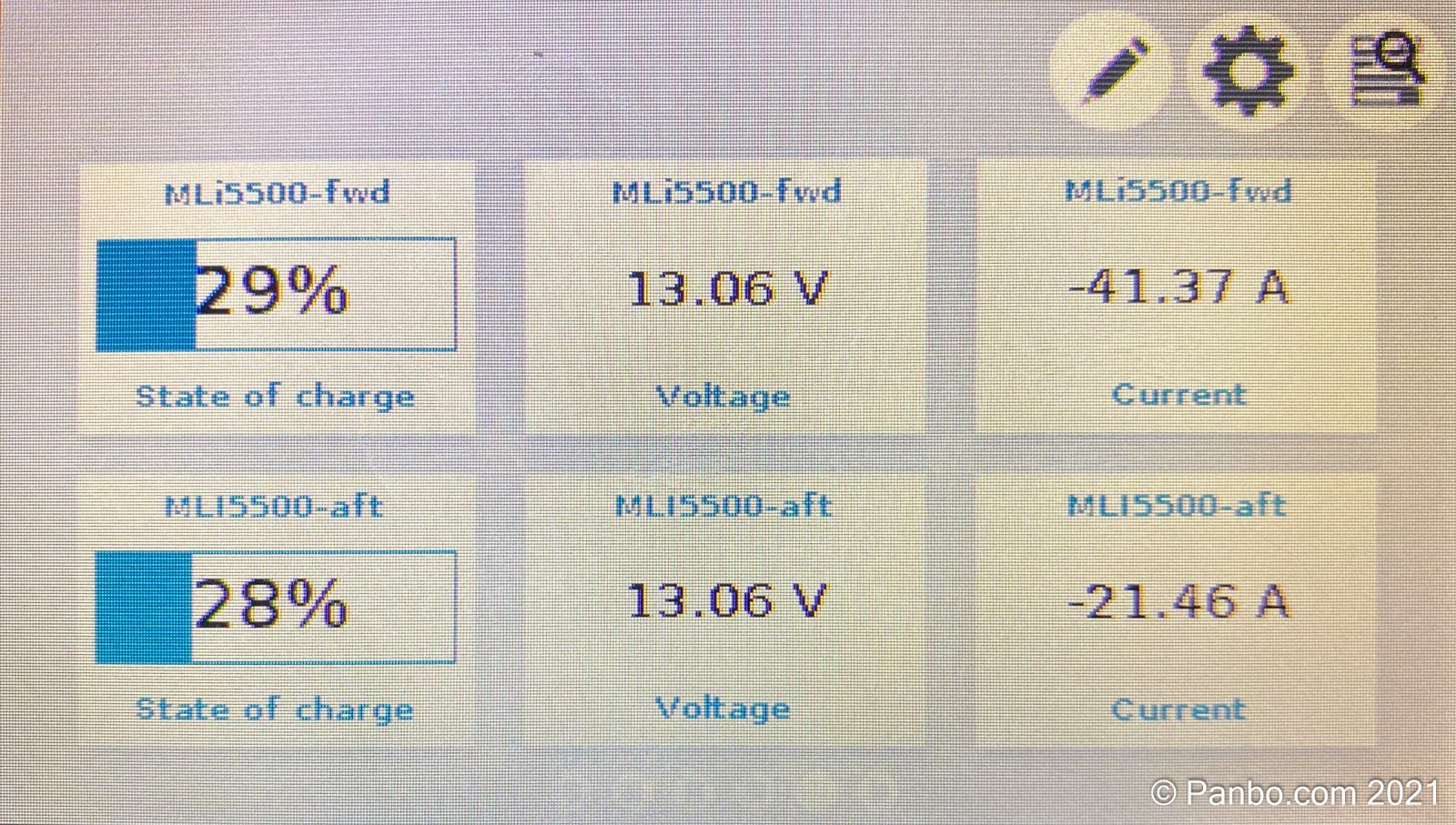
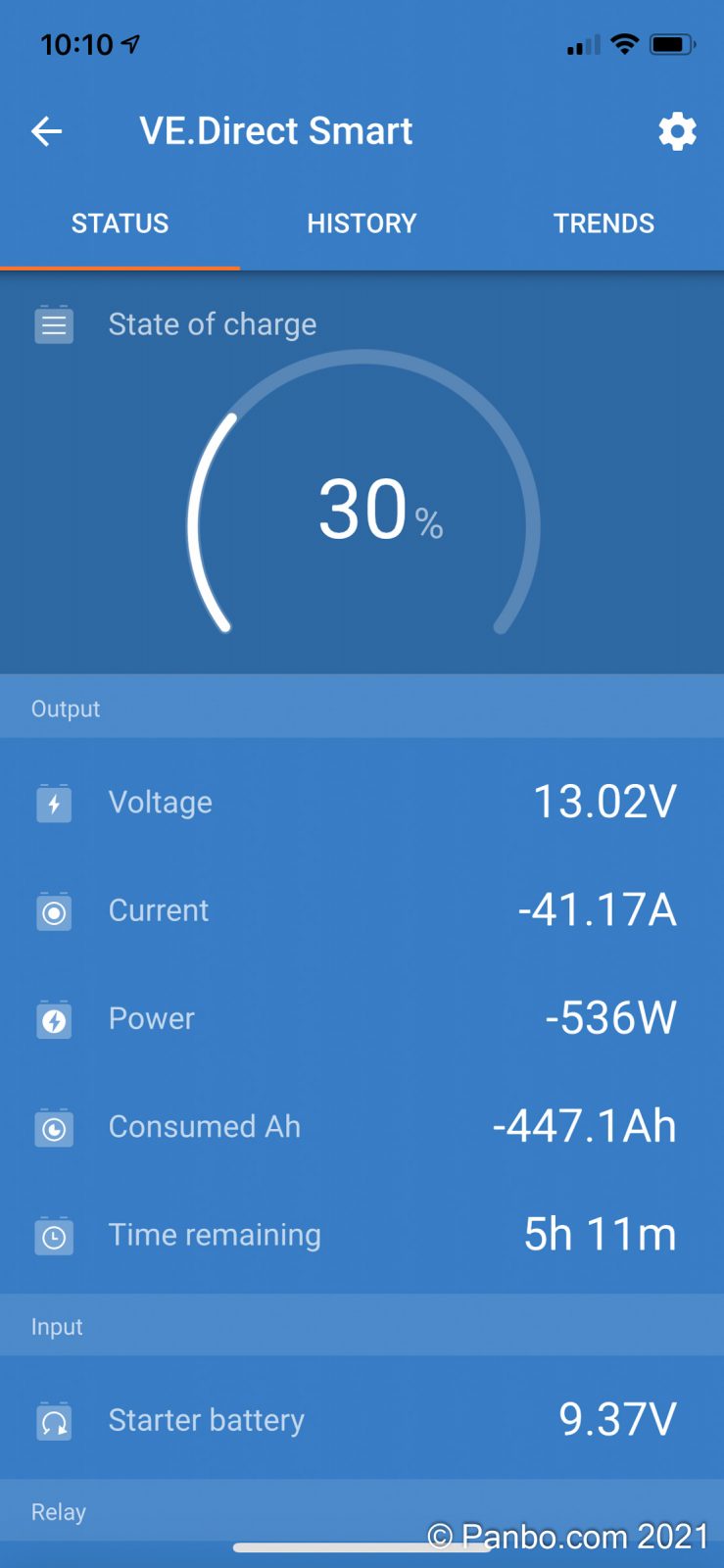
There are merits to both approaches and now that I’m aware of it I have no troubles with how Mastervolt reports. In fact, I’ve changed my BMV by setting the battery bank “size” to the 640 usable amp hours rather than the full 800, and now the two state of charge sources are always within one-percent.
Real world results

My testing began with the boat still connected to shore power but with the inverter breaker off. That put a decent load on the new batteries, letting them run our boat’s refrigerators, freezer, microwave/convection oven, TVs, and computers. But during one of these rundown tests, I forgot that my girls had their weekly Zoom cooking class from the awesome Chef Laura at Oui Chef Chicago (not my wife Laura), and the oven had run for over an hour before I remembered that the inverter was running on batteries. If I’d made this same mistake with my old battery bank, it would have quickly resulted in dimming lights, low voltage alarms, and likely a low-voltage inverter shutdown. But with the lithium system, there wasn’t a hint of trouble.
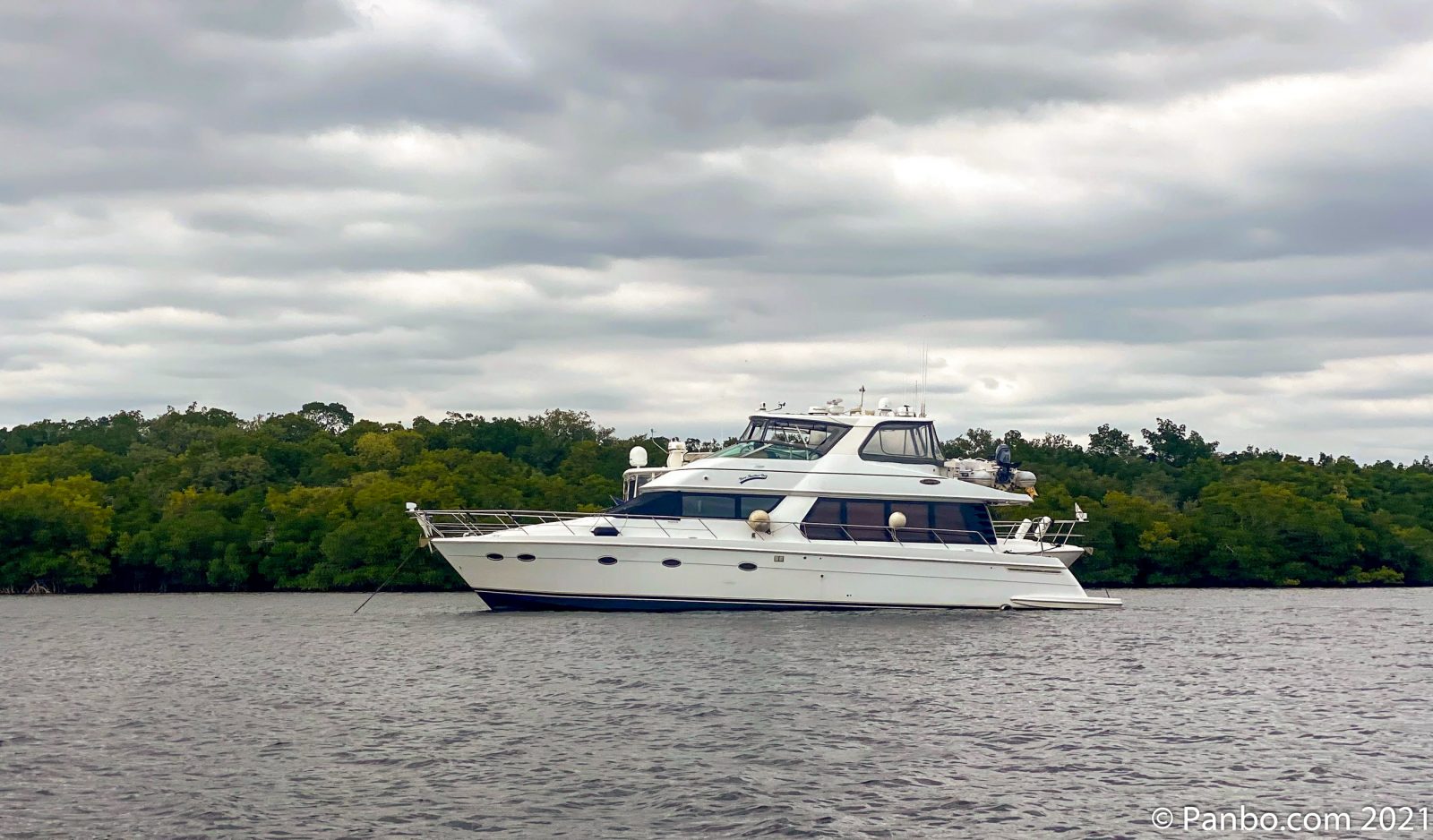
With all dockside tests looking good, it seemed prudent to get off the dock for some real world testing. It’s hard work, but someone has to do it! As seen above, a somewhat cloudy day meant that we didn’t need air conditioning and so I shut off the generator as soon as we got the hook down.
At anchor we went about living our normally well-powered lives; we cooked snacks in the microwave, listened to multiple stereos, enjoyed March Madness games on the TV, etc. We started the generator for an hour or so to make dinner and in that time the batteries got back to 100-percent SOC, the MasterCombi 12/3000-160 inverter/charger having replaced all the power we’d consumed in the previous five or six hours.
At bedtime, I didn’t do my normal procedure of shutting down all non-critical loads, instead letting them run all night. When I woke the bank was at about 45% SOC and humming along happily. I started the generator to make coffee — it’s on my list to move the coffee maker to the inverter — and it took just over two hours to get the LiFePO4 bank to 100%. So, in 24 hours at anchor we’d run the generator for less than four hours, and that will be much less once I install the Mastervolt Alpha Compact 14/300 alternator so that the port main engine can top up the bank as we motor to the next destination.
LiFePO4 safety
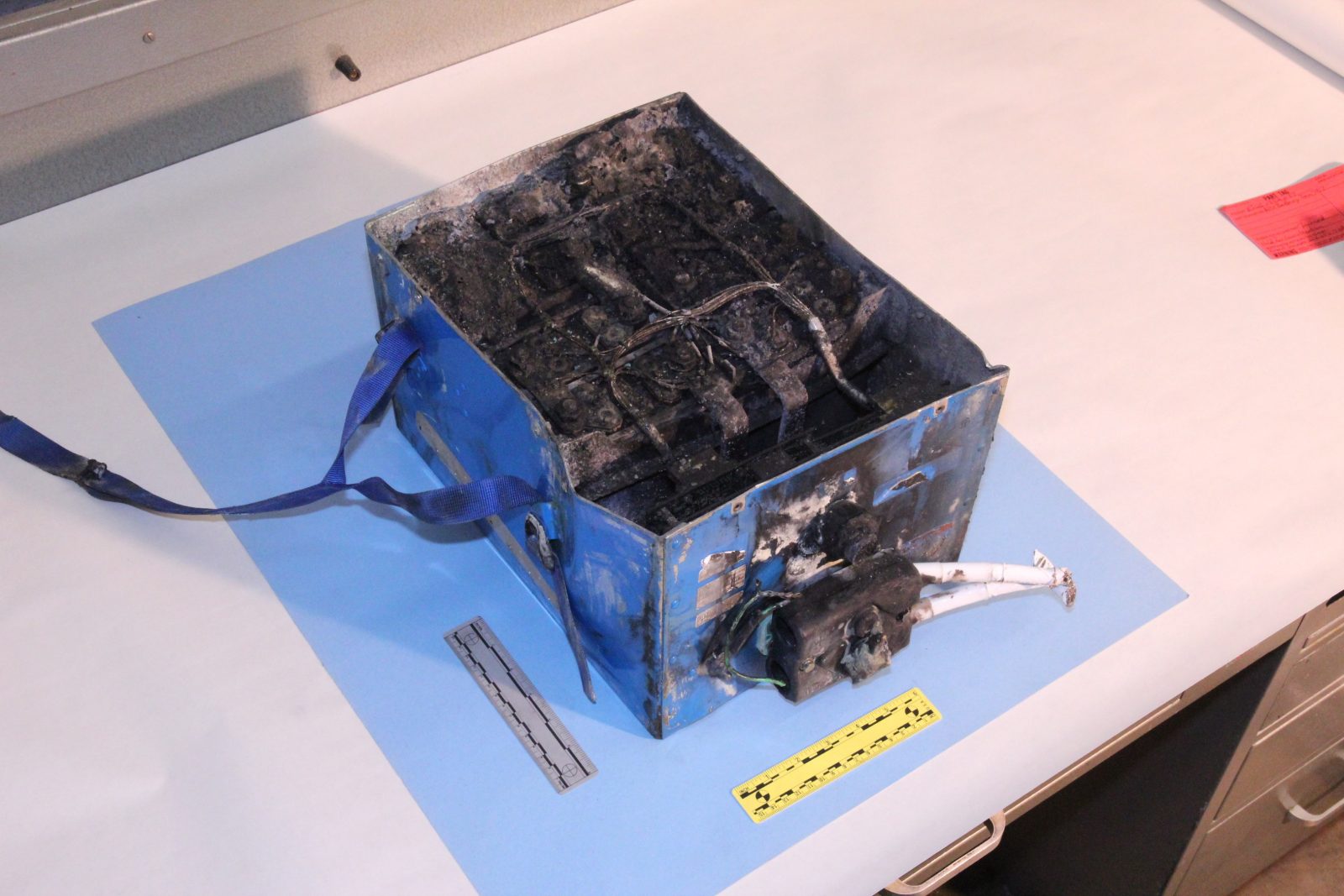
There have been several high-profile events with lithium-ion batteries including fires aboard Boeing 787s and a spate of hoverboard fires. But, while lithium iron phosphate batteries are lithium-ion batteries, they are a safer variety than those that made news. For instance, that’s a burnt lithium cobalt oxide battery (pictured above) which experienced thermal runaway inside a Boeing 787. Lithium cobalt oxide together with lithium nickel manganese cobalt oxide are responsible for the majority of the frightening events we’ve seen reported.
These other lithium-ion battery chemistries have more than twice the energy density of lithium iron phosphate, but they’re also inherently more dangerous because internal faults, external abuse, and overcharging or discharging can result in a thermal runaway. Fortunately, I don’t know of any marine use of these chemistries.
The FAA tested the safety of various lithium battery chemistries — available at www.fire.tc.faa.gov/pdf/TC-16-17.pdf — and the chart above shows the results I think most relevant to boaters. In this test, a heater forced one battery to overheat, while five connected batteries were monitored for thermal runaway. LiFePO4 was the only chemistry that didn’t propagate the failure to all five batteries. In fact, no other batteries failed and the FAA concluded that LiFePO4 is the safest of the chemistries.
I believe a solid case can be made that properly installed LiFePO4 battery systems are safer than the vast majority of lead-acid battery installations — including those on my own boats — which have few safety measures in place.
A good lead-acid install includes little more than an enclosure around the battery, a strap to hold it down, and over-current protection. In contrast, a proper LiFePO4 install has a BMS monitoring the health of each cell, the charge or discharge current, and the temperature of the battery. If any of these elements are out of range, my Mastervolt BMS can activate a Blue Sea Systems ML-RBS remote battery switch to disconnect a battery from the bus bar.
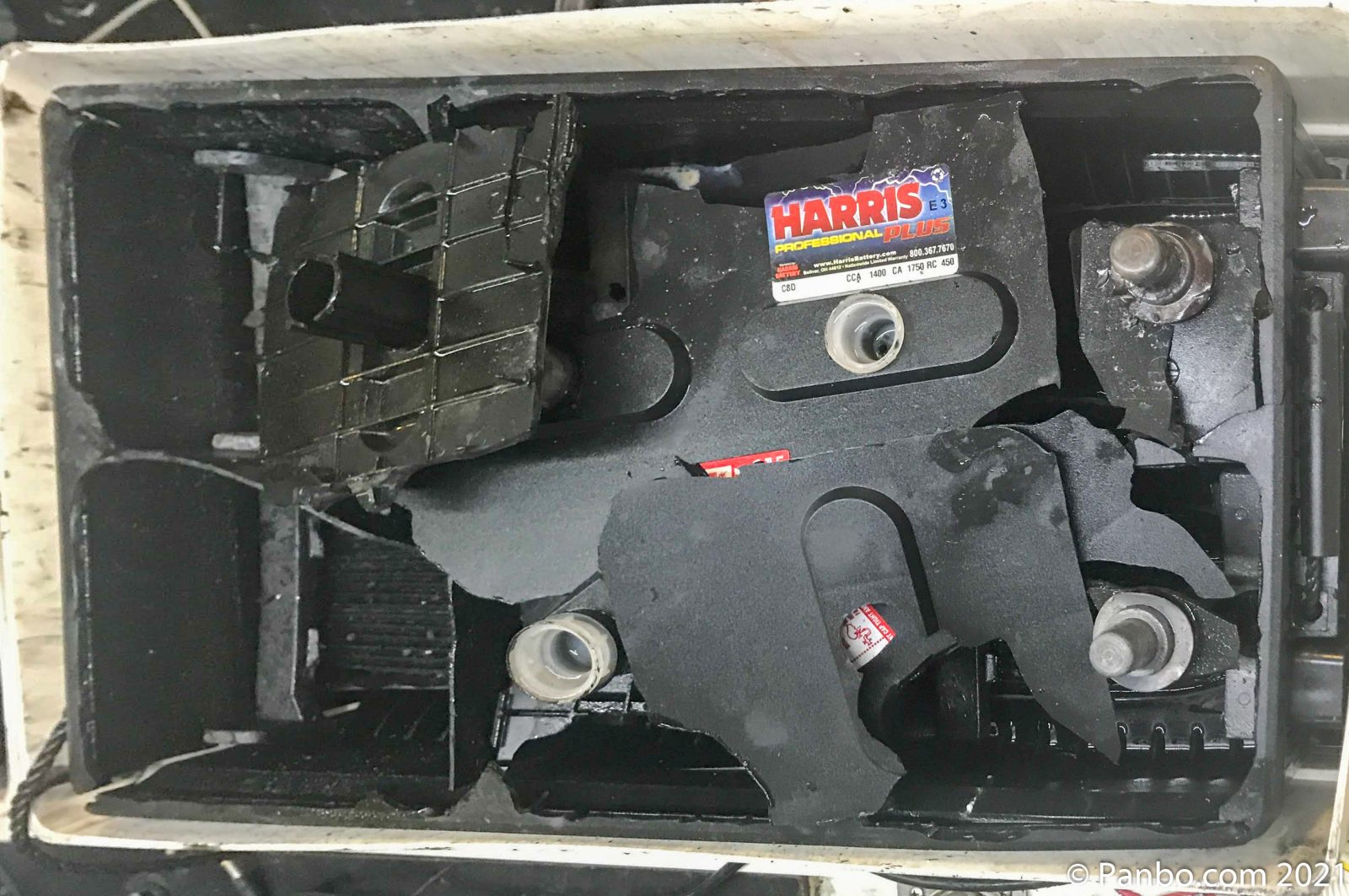
Meanwhile, a single failed cell in a lead-acid battery can easily cause overcharging in the rest of the cells. One result many experienced boaters are familiar with is the pungent, rotten-egg smell of hydrogen sulfide, a highly poisonous and explosive gas. So it’s usually the nose of a boat owner or dock neighbor that detects a failure and causes the charger to be shut down. But that doesn’t happen until the battery has already released toxic gases into your engine room. I’ve also experienced battery explosions from low electrolyte levels allowing the plates to be exposed.
I’ve heard rumors of trouble with insurance carriers when they hear lithium has been installed in a boat. I haven’t been able to track down any concrete examples. But, I did ask Menno Ligterink, Mastervolt’s OEM sales manager for RV and marine, about the safety of LiFePO4. He explained the many measures engineered into this system as well as the work they’ve done with outside safety organizations. Menno explained Mastervolt has worked with ABYC to help prepare technical information document TE-13 on safe installation of LiFePO4. Lastly, Mastervolt is currently working with UL to attain UL approval. Menno left me with this indication of his confidence in the MLi batteries he installed on his RV, “I put my batteries under my own bed.”
Cost / benefit analysis
In that recent Lithium math entry, I calculated a drop-in LiFePO4 battery cost at about $0.70 per watt hour. My new 5,500 watt hour Mastervolt MLi 12/5500 batteries can be purchased online for about $5,700, or about $1.04 per WH. In total, this system costs a little over $17,000, but unless you’re willing and able to do the install, there will also be labor expenses. It took me about 40 hours for the install and configuration, and combined with various possible extras like large DC cables, lugs, and bus bars I think this whole project could climb to somewhere north of $22,000.
That’s a major investment, and to justify that investment you need to get a major return. But my configuration is probably larger than the vast majority of boaters will need. In fact, I used the system with only one battery for a few nights at anchor and was impressed by how well that worked. I also think you could reduce cost by using a smaller alternator. Additionally, not all boats will need all their DC components changed. If I had a newer inverter or already had externally regulated alternators, I could have avoided those costs as well.
But even at full cost I believe this upgrade represents good return on your investment if you anchor with some frequency and value the ability to do so with minimal generator runtime, or don’t even have a generator.
Final thoughts
There’s still more of the upgrade story to tell. I plan to detail the MasterBus capabilities and also explain how the Mastervolt BMS can be alternately integrated with CZone or direct to NMEA 2000. I’ll also show you how some of my system’s monitoring can be output to NMEA 2000 displays and how I can use that for the remote monitoring that Mastervolt has not developed yet. And there’s also the alternator and regulator to install — which may take some pro assistance — and a look at how they integrate with the other Mastervolt components.
In the meantime, I’ll just be here on Have Another Day enjoying the fruits of my labor so far, and happy to answer questions.
















Thank you for this follow up of the Lithium installation. Very educative.
I have LI on my list to replace an older 24V/900Ah traction battery, like you stated, I cannot do this before I upgrade everything elso, to protect the LI battery.
Same like you, I made the decision for Mastervolt, because they supply the whole chain (generator/alternator, charger, inverter, and so on).
Thanks for sharing your experiences Ben! It’s really interesting to read about the process of the upgrade as there are not that many organizations that you can consult with in the upgrade. Often we have found ourselves to be on our own to figure things out. A friend of mine and myself are upgrading my wife’s and my boat, and it’s been challenging at times. We’ve not actually started the build yet, but we hope to begin this Thursday if all the components we’ve ordered arrive. Our system will have a 6 kw system with an integrated BMS. Much thought has to be given to protections, charging parametres, and the various protections for the various systems on board. Love to chat about your install or share our plans with you if you are interested!
Cam,
I’d be happy to talk about your install. I suspect others would be interested in hearing what you’re thinking as well. So, if you’re willing, I think it would be great for you to share your plans in the Panbo forum.
-Ben S.
Ben, really enjoying this mini-series, as always, thanks for taking the time to learn “real world” technology and then sharing your experiences/results.. I believe LiFePO4 will be/is becoming the goto battery technology for the marine industry and that perhaps the largest initial market for manufacturers will be retrofits on older boats. Very nice to see the technology is starting to be in place to support this for DYI’ers, albeit still at an “introductory” price level..
Hi Ben
I’d love to hear how these batteries can output information directly to NMEA2000. I recently installed 6 of the MLI 24/5500 batteries on my boat and they work great, but it would definitely be useful to be able to check on everything from standard NMEA 2000 displays.
Thanks,
Tom
The newest versions have NMEA2000 integrated:
https://www.mastervolt.com/products/li-ion/mli-ultra-24-5500/
Otherwise use a Masterbus to NMEA interface:
https://www.mastervolt.com/products/masterbus-interfaces/masterbus-nmea2000-interface/
Or Masterbus CZONE interface:
https://www.mastervolt.com/products/network-interfaces/czone-masterbus-bridge-interface1/
A very timely article, since I also recently installed lithium batteries in our boat. I took as slightly different route with Battleborn/Victron Multiplus, but my experience has been the same. I especially like that voltage doesn’t drop very much as the batteries discharge, and that they recharge at or near the capacity of the charging device,
Two things to be emphasized when planning a lithium installation.. These batteries don’t like heat, so don’t install them in the engine room, and because regulators will cut charging abruptly when the batteries reach 100%, alternators need to be protected from voltage spikes.
I have 4 MLI 24 180AH batteries, and am trying to setup the right stop charge events to my charger. Do you configure the events only from the master battery, or from both?
My 24/100-3 charger went through full absorption up to 29.3 volts, and one battery had a reduce charge alarm set, but the stop charge does not seem to kick in until higher I guess. The charger finished, but I am puzzled because the bulk and absorb settings are at 28.5, not 29.3.
I then attempted to trigger a reduce charge event to a relay module and it did not seem to work. I configured this live, after the event occurred, so maybe I should test again.
I want to optimize for longevity, so I actually want to stop charging when 28.5 is achieved, then float at 26.8. This is more conservative than stated in the manual. Any advice on the event config?
Hi
I can send you a .XML copy of a proper configured system with stop charge events. Just load the .XML in Masteradjust and compare the settings with your system.
Hi Ben,
Great articles on your upgrade to Lithium, very practical and understandable. I wonder whether you can give some advice:
I have two battery banks – 3xAGM which I want to replace with a single lithium and 1xAGM dedicated starter battery which I would like to keep. The starter battery is fully charged almost all the time. I have mostly Mastervolt infrastructure already, including a Battery Mate for split charging the two banks. I have a single engine and alternator.
So my thoughts are:
1. I have a Mastervolt Chargemaster for shore power charging, so that’s sorted as it has two independent outputs for the two banks, and they can be set to different battery types.
2. I will need to install an Alpha Pro III Regulator to control the charge from the alternator.
3. I would like to split charge from the alternator and solar (and possibly other sources such as wind or fuel cell in future).
Do you have any advice on:
1. Can I continue to use my Battery Mate to split charge the Lithium + AGM batteries, even though they are different chemistries?
2. Assuming yes to #1, as the engine battery will be fully charged most of the time, I’m thinking it is ok for the Alpha Pro to just monitor the Lithium battery, so that Lithium controls when it switches between the 3 charge modes? This also protects the lithium battery, as ALL charging will be stopped by a “Stop Charge” event across Masterbus. The AGM may be over-charged in this scenario, but that’s no different to what I already have.
3. Should I feed solar / other through the Battery Mate too? If so, how is the Lithium battery protected in a “Stop Charge” scenario, as the Battery Mate isn’t connected to Masterbus?
Ideally, I would like a Masterbus-aware split charger unit to sit in front of both banks, knowing what battery types each bank has and then I can feed all non-ChargeMaster charge feeds through this, but Mastervolt doesn’t have such a device, as far as I can see?
Best wishes and thank you for any advice you can give!
Austin.
Hi Austin,
I’ll do my best to answer as many questions as I can. But, I do want to warn you that I haven’t used several of the components you’ve mentioned in this application. But, with that warning.. here goes:
Fo your thought number 1, I was surprised the Chargemaster can support multiple chemistries on the same charger. I went and looked at the manuals and spec sheets for the 12/50-3 and don’t see any way to set separate chemistries per batter bank. Can you point me towards what you’ve found on this? It would be great if a single charger could support multiple battery chemistries.
Thought number makes sense to me. Thought number 3 seems to beg for a DC-DC converter in one direction or another. This morning there was another conversation about the use of DC-DC converters you might find relevant (https://panbo.com/building-a-diy-lifepo4-battery/#comment-219875). Instead of split cahrging, you would dump your charge sources into one battery and then use a DC-DC converter to sned charge to the other bank.
For your questions, I think the answer to number 1 is no. The Battery Mate doesn’t have any facility to offer different charge voltages or stage durations based on chemistry so you’d be using the wrong profile for one of the batteries.
Questions 2 and 3 become moot with the answer to number 1, I think. Instead, you’d be relying on DC-DC converters to control the charge from one source to another.
I think in several respects, the DC-DC converter is the device you describe at the end, except that it’s attached to one battery and feeding the other. Split chemistries aren’t simple and they’re part of why Lithium conversions, even for only one bank, are truly system upgrades.
-Ben S.
Hi Ben,
Thank you for the quick answer.
On the ChargeMaster, I’m not near the boat at the moment so can’t check, but I was sure when I first set it up a few years ago that in the configuration via either EasyView or MasterAdjust, it gave the option to specify each battery type. I am now doubting myself though, especially having also looked in the manual I see no option via DIP switches or Masterbus to configure chemistries separately.
I do note that the new ChargeMaster Plus series explicitly say that multiple battery chemistries are supported, and that they also incorporate a DC-DC converter, so for new builds that might be a good device to base a system around.
If this isn’t possible with mine, I guess I either think about replacing my Battery Mate + ChargeMaster with a ChargeMaster Plus, or my current device just becomes another DC charge source…
I hadn’t considered a DC-DC converter at all, I’ll definitely look further into that idea, it would require a re-architecture of my system but I had expected that to some extent anyway.
Thank you so much for your help.
Austin.
Austin,
Thanks, I hadn’t looked at the ChargeMaster Plus before. It looks like it addresses some of the greatest complexities of multi-chemistry and multi-voltage DC systems. I’m going to have to do some more research on just what all it can do.
-Ben S.
Hi Ben,
Me too, I’ve been reading a bit and so far it does look like a very promising piece of kit.
A.
Page 28 of the manual is very interesting indeed.
Hi Austin,
A DC-DC charge for you starter batteries will be enough, if possible to do. Charge your house battery directly from the supplies.
Even though I do not have Lithium, but FLA for both types of batteries, the traction battery needs a slightly higher voltage than the starter batteries. Alternators directly charge the house battery (with Alpha Pro regulators, highly recommend them. I have the old version without Masterbus.)
Starter batteries are charged by Balmar Digital Duo Charge devices, purchased about 20+ years ago via Victron Energy. My starter batteries last about 15 years, before I had to replace them.
Regards, Wolfgang.
Thanks Wolfgang, yes on reading more into DC-DC chargers, that definitely seems to be the way forward for my setup.
I’m actually thinking of doing it the other way around though – the primary charge from all sources going to the starter battery, then DC-DC charging my Lithium house battery from that. Then I don’t need to worry about installing / configuring emergency shutdown from a lot of different charge sources, I can just configure this once on the DC-DC charger and I know my Lithium is protected from all charge sources.
If I were ever to replace my starter battery with lithium, this would need to be re-thought of course.
Great read!!
Is or how do you make your install, on any for that matter within ABYC standards. I keep hearing that if there is a fire and these standards are not meet you’re Ins.Co. my not pay the claim.
I have only found two thing, but I am sure there could be more to this. The Install must meet the manufactories requirements and the BMS must warn you ether visually and/or audially that the BMS is going to disconnect the battery. Which I total understand! You don’t want to be entering a new harbor, docking, in a mooring field and lose power without a warning.
Thank you!
Hi Paul,
I strive to make sure my installations are ABYC compliant. As I look at these pictures I believe this installation is ABYC compliant with the exception of split loom missing from the battery cabling. I’ve since added that but don’t have updated photographs.
ABYC has published TE-13 which is a technical information document and not a full standard.
Here’s the intent statement from the document:
Much of TE-13 notes that lithium battery systems should be installed in compliance with the manufacturer’s recommendations. The document states things like, all lithium-ion battery systems should have a BMS and that a backup power source should be provided for critical loads powered by lithium battery systems. The document also notes that another lithium battery is an acceptable secondary source.
TE-13 also notes the installation requirements around temperature ranges (high and low) and the need for the batteries to be properly restrained and protected from water.
Really the only specific requirements are made by incorporating the existing E-11 electrical standards.
-Ben S.
Ben, is there any way that us boatowners can see those electrical standards without paying the big $$ for the entire thing? I would be interested in the ABYC electrical standards since I do all my own electrical work. I’ve had copies of the NEC (and the low-voltage standard) for years, but they really don’t apply all that well to boats.
Hartley,
I don’t believe there is a way. I’ve recently joined ABYC and in so doing gained access to their standards. But, I’m not yet clear on what’s acceptable for me to share and what’s not. I know that small snippets of the standards can be shared.
-Ben S.
Thank for for your response! Its this end of my project that I am worried about.
Good evening I love your install and write up.
I have two batteries on order and the rest of the system in place ready for set up when they arrive.
I have a quick question on the software to set up.
is the master adjust software in a installer or dealer mode or are all them settings ect available to the normal user?
Any pointers to a masteradjust manual? When my new to me boat arrived with all Mastervolt kit, I thought I only saw one battery (I have two clustered). Their interface isn’t that intuitive. I would expect there to be two batteries under one parent rather than one. I wasted a bit of time worried I only had one working battery.
Hi Ben
I enjoyed this article series… and to prepare for my Trans Atlantic I added the Mastervolt Combimaster 3KW/ 160amp charger with Easyview 5 and Mastershunt 500 using Masteradjust software… to charge 5 ea Firefly Group 31 batteries. Now that I’ve crossed (we’re in Gibraltar now) I’ve found that the Firefly batteries failed miserably. They were installed in 2019 but the Pandemic left them on float charge for an extended time… The capacity has fallen the less than 10% of the original 580 Ahr. I would love to install LifPO4 batteries but the insurers are highly discouraging of this. I have since successfully challenged the ABYC Marine Electrical Tech exam… I’m looking at the Epoch batteries but not sure how the BMS can possibly interface with Masterbus… I will return to Gibraltar beginning April… Thanks for any comment
Hi Tom,
I am also looking for a possibility to connect Masterbus to a BMS (can). Should be possible with the CANopen Interface, but I cannot find any examples. Mastervolt is a much more closed system than for eaxample Victron. That will be trail and error in this regard.
My next best guess is to use NMEA2000 data. With the CZONE bridge interface you can pass data and events to the Masterbus (and vice versa), which contains NMEA2000 data. The Mastershunt is also available in NMEA2000 version, so it should be possible to go this way.
For the Orion BMS there is some manual to pass battery data to the NMEA2000 bus, with a CAN 2 CAN interface/gateway. Downside are the many interfaces needed (which increases the possibility of faillures).
(I have already CZONE and Mastervolt installation, in my case it would just be one additional interface.)
Please let me know if or weather you find a solution.
Wolfgang
A more ideal situation would be to bring the MLI 6000 or similar in a reachable price range perhaps… The Epoch seems to a “work in progress” given the continually changing bulb/Absorb profile recommendations I’m seeing… not sure how different the MV vs Victron BMSs are relative to generic Lifpo4…